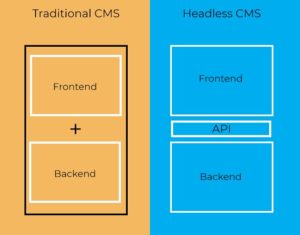- September 22, 2022
- Posted by: Yadu Dev
- Category: Engineering

Why Headless CMS and Why Strapi?
What is a headless CMS?
A headless Content Management System is a backend-only CMS. The head of the system that is the presentation layer, is separate from the body (Content repository or Database). Thus, the body is chopped off, and the CMS is then called Headless CMS.
Which allows you and members across your organization to manage and write content, and then access it across all your applications using an API.
If we can say the working of a headless CMS in a simplified way, then it should be like, Content creators create and upload the content to the Headless CMS, which stores this content on the cloud. The developers then fetch it through an API and deliver it to any kind of front end.
Why Headless CMS?
Traditional CMS limitations:
We know that Many well-known traditional CMSs are there and still they dominate the market. But, they have some limitations including
- Scalability: Growing your business and improving workflows will be significantly hindered by reliance on developers and technical glitches
- Support: These open-source systems have a great community but lack the technical resources you need to grow an enterprise company
- Security: Traditional CMS puts your company and customers at risk- they lack the infrastructure to keep your digital content Secure
- Speed: These outdated systems are notoriously slow and hinder your ability to rank content
Comparison
| Traditional CMS | Headless CMS | |
| Choice of technologies | Restricted | Limitless |
| Backend architecture | Monolithic, all-in-one | Microservice, best-in-class |
| Omnichannel support | Restricted | Limitless |
| Content model | Built for a single page | Built for many formats and products |
| Speed | Longer load times | Faster load times |
| Developer experience | Legacy | Modern |
| Use of plug-ins | Yes | Custom solutions |
| Technical debt | Inherent to provider | Managed |
| Localization | Yes | Yes |
| Hosting & delivery | Provider specific | Your choice |
| Workflow | Waterfall | Agile |
| Integration and deployment | Punctuated | Continuous |
| Updates | Scheduled | Continuous |
| Vendor lock-in | Locked to the provider | Freedom of choice |
What is Strapi?
Basically, Strapi is a headless CMS(Content Management System), In which you will be able to create an API without any backend knowledge. And Strapi gives you a lot of flexibility in terms of data modeling and APIs. It automatically generates standard CRUD APIs for any kind of data model and you can use these APIs wherever you want. That’s why it’s the perfect tool to build a custom headless content management system.
Also, there are some other strong reasons to choose Strapi, can we have a look at it?
Why Strapi?
- It’s Free & Open-Source: As you know Strapi is free to use. Not only that, you can contribute on Github too. You can even fork the code and improve it to meet your requirements. It has also greater community support too.
- Strapi is very flexible and easy to use: Strapi is out of the box, but it can be adapted to your needs. Strapi has a built-in ORM that allows you to build simple or complex content types without writing code. But if you are looking for more complex features, you can achieve them using node scripts.
- Data modeling is very easy with Strapi: You can create any kind of relational data including One-to-Many and Many-to-Many relationships, using Strapi’s admin UI.
- REST and GraphQL APIs: Strapi gives you out-of-the box documented REST and GraphQL APIs. Just create your entities in the Strapi Admin and you can get the Swagger/GraphQL documentation for free.If you’re writing any custom end-points or making changes to existing ones and you need more documentation for your API, there’s a built-in documentation generator that generates beautiful Swagger pages
- Authentication and Authorization: Strapi provides an authentication system that can be easily customized to your needs and gives the ability to control who can consume your data using APIs. You can create several types of users and groups and manage the permissions using different strategies.
- Internationalization: Many CMSs are still suffering from poor i18n support. Not with Strapi. With its latest release, Strapi now has gained the ability to provide translation to any data entity. This means that you can now serve content to a wider audience without much-ado.
- Easy customization: Strapi started as an MVC framework for NodeJS and it’s still the same internally.You can easily add more API end-points as per your requirements and write custom logic in models and controllers for it. You can customize existing endpoints as well. You can also provide authentication and authorization for the custom endpoints. The Admin panel is also very customizable thanks to React.
- Better and more powerful architecture: If you want to build APIs that can be easily accessed from the front end, then this is the right place. The robust architecture of this framework provides everything you need to build APIs. All the power provided by Strapi comes from its modular architecture. All plugins are installed via npm, and this makes them really easy to set up. Each module also follows the standards of Node.js and is designed to be fully integrated into any server or framework.
Disadvantages of Strapi headless CMS:
Like in any other case, Strapi also has some limitations including
- Limited database migration/seed support.
- Limited TypeScript support.
- Frequent updates.
Do you need Strapi?
If you really want to scale your content and have multiple integration requirements, we’d say yes. You can use Strapi to build any type of content-oriented applications including delivery to portable IoT devices or internal tools.


